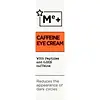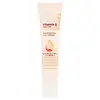What's inside
What's inside
 Key Ingredients
Key Ingredients

 Benefits
Benefits

 Concerns
Concerns

 Ingredients Side-by-side
Ingredients Side-by-side

Water
Skin ConditioningCaprylic/Capric Triglyceride
MaskingPropylene Glycol
HumectantButyrospermum Parkii Butter
Skin ConditioningIsopropyl Myristate
EmollientGlyceryl Stearate
EmollientDimethicone
EmollientPolyglyceryl-3 Methylglucose Distearate
EmulsifyingCaffeine
Skin ConditioningStearyl Alcohol
EmollientPhenoxyethanol
PreservativeCoffea Arabica Seed Extract
MaskingBetaine
HumectantStearic Acid
CleansingCaprylyl Glycol
EmollientCarbomer
Emulsion StabilisingGlycerin
HumectantXanthan Gum
EmulsifyingButylene Glycol
HumectantLecithin
EmollientTocopheryl Acetate
AntioxidantDisodium EDTA
Sodium Hydroxide
BufferingTetrapeptide-21
Skin ConditioningWater, Caprylic/Capric Triglyceride, Propylene Glycol, Butyrospermum Parkii Butter, Isopropyl Myristate, Glyceryl Stearate, Dimethicone, Polyglyceryl-3 Methylglucose Distearate, Caffeine, Stearyl Alcohol, Phenoxyethanol, Coffea Arabica Seed Extract, Betaine, Stearic Acid, Caprylyl Glycol, Carbomer, Glycerin, Xanthan Gum, Butylene Glycol, Lecithin, Tocopheryl Acetate, Disodium EDTA, Sodium Hydroxide, Tetrapeptide-21
Water
Skin ConditioningIsopropyl Palmitate
EmollientGlycerin
HumectantCetearyl Alcohol
EmollientArachidyl Alcohol
EmollientBetaine
HumectantCyclopentasiloxane
EmollientBehenyl Alcohol
EmollientCyclohexasiloxane
EmollientHydrogenated Polydecene
EmollientSaccharomyces Cerevisiae Extract
Skin ConditioningRhodiola Rosea Root Extract
EmollientAesculus Hippocastanum Seed Extract
Skin ConditioningRetinyl Palmitate
Skin ConditioningInositol
HumectantCalcium Pantothenate
Linoleic Acid
CleansingBiotin
AntiseborrhoeicTocopheryl Acetate
AntioxidantTocopherol
AntioxidantAluminum Starch Octenylsuccinate
AbsorbentLauroyl Lysine
Skin ConditioningHydroxyethyl Acrylate/Sodium Acryloyldimethyl Taurate Copolymer
Emulsion StabilisingSqualane
EmollientPolysorbate 60
EmulsifyingButylene Glycol
HumectantPentylene Glycol
Skin ConditioningXanthan Gum
EmulsifyingArachidyl Glucoside
EmulsifyingAlcohol Denat.
AntimicrobialPEG-35 Castor Oil
EmulsifyingPolysorbate 20
EmulsifyingPhenoxyethanol
PreservativeEthylhexylglycerin
Skin ConditioningPotassium Hydroxide
BufferingCitric Acid
BufferingDisodium EDTA
Water, Isopropyl Palmitate, Glycerin, Cetearyl Alcohol, Arachidyl Alcohol, Betaine, Cyclopentasiloxane, Behenyl Alcohol, Cyclohexasiloxane, Hydrogenated Polydecene, Saccharomyces Cerevisiae Extract, Rhodiola Rosea Root Extract, Aesculus Hippocastanum Seed Extract, Retinyl Palmitate, Inositol, Calcium Pantothenate, Linoleic Acid, Biotin, Tocopheryl Acetate, Tocopherol, Aluminum Starch Octenylsuccinate, Lauroyl Lysine, Hydroxyethyl Acrylate/Sodium Acryloyldimethyl Taurate Copolymer, Squalane, Polysorbate 60, Butylene Glycol, Pentylene Glycol, Xanthan Gum, Arachidyl Glucoside, Alcohol Denat., PEG-35 Castor Oil, Polysorbate 20, Phenoxyethanol, Ethylhexylglycerin, Potassium Hydroxide, Citric Acid, Disodium EDTA
 Reviews
Reviews

Ingredients Explained
These ingredients are found in both products.
Ingredients higher up in an ingredient list are typically present in a larger amount.
Betaine is a common humectant (a substance that promotes retention of moisture). It's known to be gentle on the skin and can help balance hydration.
This ingredient is best for improving hydration and soothing irritated skin. Studies also show it helps even out skin tone.
Fun fact: Betaine is naturally created in the skin and body. The kind found within cosmetic products can be either plant-derived or synthetic.
Another name for betaine is trimethylglycine.
Learn more about BetaineButylene Glycol (or BG) is used within cosmetic products for a few different reasons:
Overall, Butylene Glycol is a safe and well-rounded ingredient that works well with other ingredients.
Though this ingredient works well with most skin types, some people with sensitive skin may experience a reaction such as allergic rashes, closed comedones, or itchiness.
Learn more about Butylene GlycolDisodium EDTA plays a role in making products more stable by aiding other preservatives.
It is a chelating agent, meaning it neutralizes metal ions that may be found in a product.
Disodium EDTA is a salt of edetic acid and is found to be safe in cosmetic ingredients.
Learn more about Disodium EDTAGlycerin is already naturally found in your skin. It helps moisturize and protect your skin.
A study from 2016 found glycerin to be more effective as a humectant than AHAs and hyaluronic acid.
As a humectant, it helps the skin stay hydrated by pulling moisture to your skin. The low molecular weight of glycerin allows it to pull moisture into the deeper layers of your skin.
Hydrated skin improves your skin barrier; Your skin barrier helps protect against irritants and bacteria.
Glycerin has also been found to have antimicrobial and antiviral properties. Due to these properties, glycerin is often used in wound and burn treatments.
In cosmetics, glycerin is usually derived from plants such as soybean or palm. However, it can also be sourced from animals, such as tallow or animal fat.
This ingredient is organic, colorless, odorless, and non-toxic.
Glycerin is the name for this ingredient in American English. British English uses Glycerol/Glycerine.
Learn more about GlycerinPhenoxyethanol is a preservative that has germicide, antimicrobial, and aromatic properties. Studies show that phenoxyethanol can prevent microbial growth. By itself, it has a scent that is similar to that of a rose.
It's often used in formulations along with Caprylyl Glycol to preserve the shelf life of products.
Tocopheryl Acetate is AKA Vitamin E. It is an antioxidant and protects your skin from free radicals. Free radicals damage the skin by breaking down collagen.
One study found using Tocopheryl Acetate with Vitamin C decreased the number of sunburned cells.
Tocopheryl Acetate is commonly found in both skincare and dietary supplements.
Learn more about Tocopheryl AcetateWater. It's the most common cosmetic ingredient of all. You'll usually see it at the top of ingredient lists, meaning that it makes up the largest part of the product.
So why is it so popular? Water most often acts as a solvent - this means that it helps dissolve other ingredients into the formulation.
You'll also recognize water as that liquid we all need to stay alive. If you see this, drink a glass of water. Stay hydrated!
Learn more about WaterXanthan gum is used as a stabilizer and thickener within cosmetic products. It helps give products a sticky, thick feeling - preventing them from being too runny.
On the technical side of things, xanthan gum is a polysaccharide - a combination consisting of multiple sugar molecules bonded together.
Xanthan gum is a pretty common and great ingredient. It is a natural, non-toxic, non-irritating ingredient that is also commonly used in food products.
Learn more about Xanthan Gum